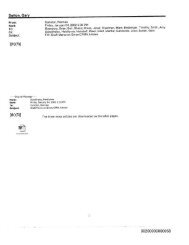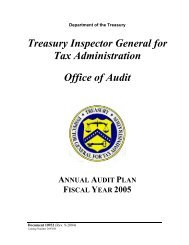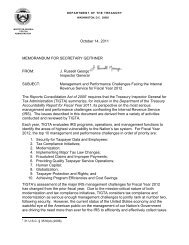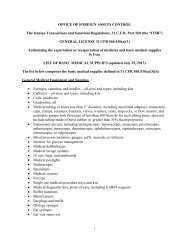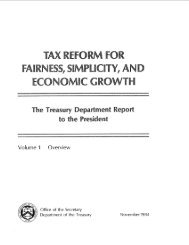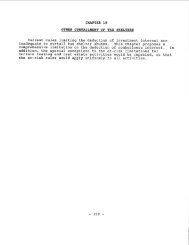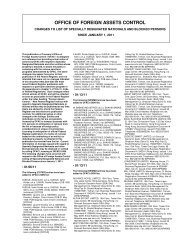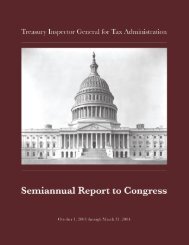PDF - Department of the Treasury
PDF - Department of the Treasury
PDF - Department of the Treasury
You also want an ePaper? Increase the reach of your titles
YUMPU automatically turns print PDFs into web optimized ePapers that Google loves.
Processing Returns and<br />
Implementing Tax Law<br />
Changes<br />
The IRS provides tax benefits to taxpayers<br />
identified on <strong>the</strong> IRS Master File 13 as being<br />
in a Combat Zone. However, TIGTA<br />
identified a processing issue that affects <strong>the</strong><br />
accuracy <strong>of</strong> <strong>the</strong> Combat Zone indicators<br />
and <strong>the</strong> overall effectiveness and efficiency<br />
<strong>of</strong> <strong>the</strong> Combat Zone program.<br />
TIGTA results indicated that over 58 percent<br />
<strong>of</strong> <strong>the</strong> 520,000 taxpayers with an active<br />
Combat Zone indicator are incorrect<br />
(i.e., <strong>the</strong> taxpayers are no longer serving<br />
in a Combat Zone). An incorrect active<br />
Combat Zone status allows taxpayers to<br />
receive special tax treatment to which <strong>the</strong>y<br />
are no longer entitled to receive, such as<br />
filing late, not being audited, or having<br />
collection action suspended.<br />
13 The Master File refers to <strong>the</strong> IRS Individual Master<br />
File database that maintains transactions or records<br />
<strong>of</strong> individual tax accounts.<br />
To fur<strong>the</strong>r help ensure that Combat Zone<br />
indicators are correct, TIGTA<br />
recommended that <strong>the</strong> IRS continue to<br />
work on perfecting <strong>the</strong> information used to<br />
update <strong>the</strong> Master File, develop a quality<br />
review program to ensure that <strong>the</strong> accounts<br />
being analyzed for inaccurate indicators by<br />
<strong>the</strong> new computer program are processed<br />
correctly, and conduct an account review on<br />
an annual basis. IRS management agreed<br />
with <strong>the</strong> recommendations and initiated<br />
corrective action.<br />
Report Reference No. 2005-40-077<br />
More improvements can be made to<br />
enhance <strong>the</strong> clarity and usefulness <strong>of</strong> math<br />
error notices and reduce unnecessary<br />
notices issued to individual and business<br />
taxpayers.<br />
Many taxpayers who calculated <strong>the</strong>ir own<br />
estimated tax penalties received an<br />
unnecessary and confusing math error<br />
notice telling <strong>the</strong>m <strong>the</strong>y miscalculated <strong>the</strong><br />
total balance <strong>the</strong>y owed on <strong>the</strong>ir tax returns.<br />
As illustrated on <strong>the</strong> following page,<br />
instructions on TY 2004 U.S. Individual<br />
Income Tax Returns (Form 1040), Line 74<br />
(Amount You Owe) tell taxpayers to,<br />
“Subtract Line 70 (Total Payments) from<br />
Line 62 (Total Tax).”<br />
Taxpayers who followed <strong>the</strong>se instructions<br />
and also entered an estimated tax penalty on<br />
<strong>the</strong> next line (Line 75) received a math<br />
error notice stating:<br />
“We changed <strong>the</strong> refund amount on<br />
Line 72a or <strong>the</strong> amount you owe on<br />
Line 74 <strong>of</strong> your Form 1040 because <strong>the</strong><br />
amount entered on your tax return was<br />
computed incorrectly.”<br />
April 1, 2005 to September 30, 2005 17



